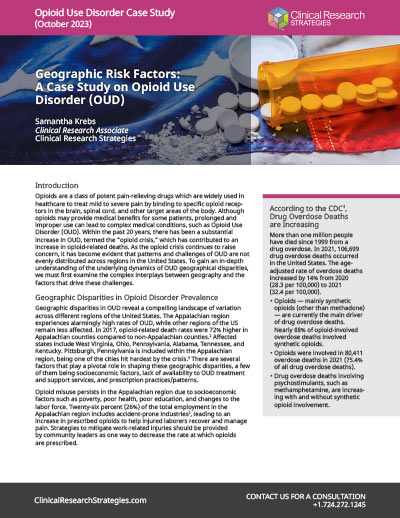GEOGRAPHIC RISK FACTORS: A CASE STUDY ON OPIOID USE DISORDER (OUD)
Geographic Risk Factors: A Case Study on Opioid Use Disorder (OUD)
Samantha Krebs
Clinical Research Associate, Clinical Research Strategies
OCTOBER 2023
Opioids are a class of potent pain-relieving drugs which are widely used in healthcare to treat mild to severe pain by binding to specific opioid receptors in the brain, spinal cord, and other target areas of the body. Although opioids may provide medical benefits for some patients, prolonged and improper use can lead to complex medical conditions, such as Opioid Use Disorder (OUD). Within the past 20 years, there has been a substantial increase in OUD, termed the “opioid crisis,” which has contributed to an increase in opioid-related deaths. As the opioid crisis continues to raise concern, it has become evident that patterns and challenges of OUD are not evenly distributed across regions in the United States. To gain an in-depth understanding of the underlying dynamics of OUD geographical disparities, we must first examine the complex interplays between geography and the factors that drive these challenges.
Geographic Disparities in Opioid Disorder Prevalence
Geographic disparities in OUD reveal a compelling landscape of variation across different regions of the United States. The Appalachian region experiences alarmingly high rates of OUD, while other regions of the US remain less affected. In 2017, opioid-related death rates were 72% higher in Appalachian counties compared to non-Appalachian counties.[2] Affected states include West Virginia, Ohio, Pennsylvania, Alabama, Tennessee, and Kentucky. Pittsburgh, Pennsylvania is included within the Appalachian region, being one of the cities hit hardest by the crisis.[3] There are several factors that play a pivotal role in shaping these geographic disparities, a few of them being socioeconomic factors, lack of availability to OUD treatment and support services, and prescription practices/patterns.
Opioid misuse persists in the Appalachian region due to socioeconomic factors such as poverty, poor health, poor education, and changes to the labor force. Twenty-six percent (26%) of the total employment in the Appalachian region includes accident-prone industries[2], leading to an increase in prescribed opioids to help injured laborers recover and manage pain. Strategies to mitigate work-related injuries should be provided by community leaders as one way to decrease the rate at which opioids are prescribed.
Those living in the Appalachian region face geographical barriers which make it challenging to receive OUD treatment and services. The rurality of Appalachia and its sparsely populated areas make it extremely difficult for healthcare facilities to be established and maintained. These communities also experience a shortage of healthcare workers, making it even more difficult for OUD treatment to be provided. The number of primary care physicians (PCPs) are inadequate to meet these unique needs in this region, with 12% fewer per 100,000 residents compared to the entirety of the country’s population.[4]
Prescription practices and patterns also contribute to the increased rates of opioid misuse, addiction, and overdose. The opioid dispensing rate varies drastically from state to state. In 2006, West Virginia had an opioid dispensing rate of 129.9 prescriptions per 100 people, whereas the entire United States had a national dispensing rate much lower. 60 Minutes featured several stories in recent years, including on the Huntington, West Virginia crises.[5] In 2020, Alabama had a dispensing rate of 80.4 prescriptions per 100 persons, compared to the United States with 43.3 prescriptions per 100 people.[6] The increase of opioid prescribing initiated the opioid crisis and in 2017, rates of opioid prescriptions were 45% higher in counties of the Appalachian region compared to non-Appalachian counties.2 The overdose rate from 2012 to 2017 continued to grow due to the arrival of synthetic opioids,2 which are obtained through the illicit drug market. Factors altering opioid availability rates include illicit drug trafficking routes, overprescribing clinics, and lax regulation of pharmaceutical distribution.
There has been criticism with the way the pharmaceutical industry made billions by contributing to prescribing incentives, and the Food and Drug Administration (FDA) erroneously ignored the review of the addictive nature of such drugs. Another 60 Minutes episode laid a significant portion of the blame on industry and the regulators.[7] As a result, multi-billion-dollar fines or pending civil lawsuits, such as $6B Purdue Pharma litigation,[8] have not seemed to slow down the crisis. To improve regulatory oversight, the FDA has held hearings and improved guidances for finding alternative medicines or monitoring devices, seeking innovation from industry.[9]
According to the CDC[1], Drug Overdose Deaths are Increasing
More than one million people have died since 1999 from a drug overdose. In 2021, 106,699 drug overdose deaths occurred in the United States. The age-adjusted rate of overdose deaths increased by 14% from 2020 (28.3 per 100,000) to 2021 (32.4 per 100,000).
- Opioids — mainly synthetic opioids (other than methadone) — are currently the main driver of drug overdose deaths. Nearly 88% of opioid-involved overdose deaths involved synthetic opioids.
- Opioids were involved in 80,411 overdose deaths in 2021 (75.4% of all drug overdose deaths).
- Drug overdose deaths involving psychostimulants, such as methamphetamine, are increasing with and without synthetic opioid involvement.
A Pittsburgh Company Making a Difference: Resilient Lifescience
Brad Holden and Charlie Proctor, the founders of Resilient Lifescience, a Pittsburgh-area-based life sciences company, aim to answer the regulators’ call to reduce opioid-related deaths by developing a wearable device that monitors vital signs to detect and reverse an opioid overdose.[10] Diving into the research of the opioid crisis has allowed them to determine that over seventy percent (70%) of opioid related deaths occur without a bystander present. Committed to leveraging the power of medical device technology to improve the lives of people living with opioid addiction and their loved ones, Brad and Charlie are currently in the development phase of their device, focusing on the build and design to provide optimal efficiency. Positive feedback has been received regarding this product from both users and families in hopes of catching signals early and avoiding unnecessary death. Resilient Lifescience explains there are other applications they will work towards where a similar device detects vitals with non-invasive measurements following a subcutaneous injection in emergency situations. The current device is being focused since the opioid crisis is costing our country over 136 lives a day.[11]
“In our research, we’ve seen just how ubiquitous and complex the opioid epidemic is and how costly OUD can be to treat. We are developing technology to help keep people safe from overdose, regardless of their access to other forms of treatment.”
— Charlie Proctor

Brad Holden, Resilient Lifescience Co-founder & CEO

Charlie Proctor, Resilient Lifescience Co-founder & CTO
Clinical Research Strategies (CRS) as a Helping Hand
Evaluating the relationship between geographic disparities and OUD allows CRS to recommend tailored interventions for regions facing opioid-related challenges through our integrated quality, regulatory, and clinical service offerings. The public school system can teach students about the risks of opioid use by introducing them to stories of recovering individuals. Opioid misuse should be included in school health curricula ensuring all children are properly educated on this topic. In 2013, the superintendent of a public school district located in an Appalachian region (Alleghany County, Maryland) began educating students by inviting residents in recovery to speak in health classes about the dangers of opioid misuse. County sheriffs became involved in educating parents and students on how to locate hidden drugs. These programs resulted in a 14% decrease in overdose deaths from 2016 to 2017.[2] The CDC’s Guideline for Prescribing Opioids for Chronic Pain – 2016 [12] provides recommendations for appropriate opioid prescribing. Ensuring patients are aware of the benefits and risks associated with these medications is vital. Additional resources are provided below for those of you who may know a friend, family member, or loved one who is struggling with OUD.
Additional Resources
Allegheny County Health Department Harm Reduction Resources
Pennsylvania Department of Human Services – Centers of Excellence
Pennsylvania Department of Human Services – 988 National Mental Health Crisis Line
Treating Heroin and Opioid Use Disorder
The Commonwealth of Pennsylvania Prevention Alliance Campaign
CONCLUSION
Deploying effective interventions targeting OUD risk factors is crucial to decreasing the alarming rates of overdose deaths seen in the United States. CRS and start-up companies like Resilient Lifescience recognize the devastating impact that the opioid crisis has caused thus far and remains committed, persistently advocating for change, and offering support for tackling this crisis. Together, we are inspired to work with regulators, local community leaders, life science companies, research sites, patients, and care givers to alleviate the impact of the crisis, resulting in healthier communities.
References
1. Drug Overdose Deaths Remained High in 2021
https://www.cdc.gov/drugoverdose/deaths/index.html
2. Opioids in Appalachia: The Role of Counties in Reversing a Regional Epidemic
https://www.naco.org/resources/featured/opioids-appalachia
3. The Opioid Epidemic: UPMC and the University of Pittsburgh Schools of the Health Sciences Confront the Crisis
https://www.upmc.com/media/media-kit/opioid-epidemic
4. Health Disparities in Appalachia: Health Care Systems (PDF: 6.9 MB)
https://www.arc.gov/wp-content/uploads/2021/02/Health_Disparities_in_Appalachia_Health_Care_Systems_Domain.pdf
5. 60 Minutes: Huntington, WV fights their city’s opioid crisis
https://www.youtube.com/watch?v=0TAdrW9I8P8
6. U.S. Opioid Dispensing Rate Maps
https://www.cdc.gov/drugoverdose/rxrate-maps/index.html
7. 60 Minutes: The Opioid Epidemic: Who is to blame?
https://www.cbsnews.com/news/the-opioid-epidemic-who-is-to-blame-60-minutes-2020-06-21/
8. Purdue Pharma: Supreme Court blocks $6 billion opioid settlement that would have given the Sackler family immunity
https://www.cnn.com/2023/08/10/politics/supreme-court-purdue-pharma-opioid-settlement/index.html
9. FDA Finalizes Guidance to Encourage Development of Novel Medicines to Treat Opioid Use Disorder
https://www.fda.gov/news-events/fda-brief/fda-brief-fda-finalizes-guidance-encourage-development-novel-medicines-treat-opioid-use-disorder
10. Resilient Lifescience
https://www.resilient.bio/
11. Drug Overdose Death Rates
https://drugabusestatistics.org/drug-overdose-deaths/
12. CDC’s Guideline for Prescribing Opioids for Chronic Pain – 2016
https://www.cdc.gov/mmwr/volumes/65/rr/rr6501e1.htm
ABOUT THE AUTHOR
SAMANTHA KREBS
Clinical Research Associate
Samantha is a graduate of the Pennsylvania State University and a Clinical Research Associate at Clinical Research Strategies (CRS). During her time at Penn State, she studied Biobehavioral Health with interest in opioid research — specifically the opioid crisis — and was included in the inaugural cohort of Penn State’s Clinical Research Program. She received Adult Mental Health training, as well as First Aid and CPR. Samantha is continuing her clinical research education by completing the Barnetts CRA & CRC Beginner Program. Samantha conducts monitoring visits, both remote and in-person, ensuring good clinical practice to optimize the quality and integrity of clinical data and protect the rights, safety, and welfare of human subjects.
SAMANTHA KREBS
Clinical Research Associate


